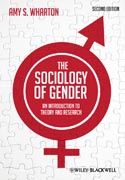
Featuring extensive revisions and updates, the Second Edition of The Sociology of Gender: An Introduction to Theory and Research presents an introductory overview of gender theory and research, and continues to offer a unique and compelling approach to one of the most important topics in the field of sociology. Features extensive revisions and updates, and incorporates recent cross-national research on gender Expands and develops frameworks introduced in first edition Treats gender as a multilevel system operating at the individual, interactional, and institutional levels Stresses conceptual and theoretical issues in the sociology of genderOffers an accessible yet intellectually sophisticated approach to current gender theory and research Includes pedagogical featuresdesigned to encourage critical thinking and debate INDICE: Chapter 1: Introduction to the Sociology of Gender. 1. Chapter Objectives. 2. Introduction. 3. Sociological Vantage Points. 4. A Brief History of the Sociological Study of Gender. 5. Defining Gender. 6. Three Frameworks for Understanding Gender. 7. Gender Matters. 8. Who is to Blame?: Understanding Gender Inequality. 9. Chapter Summary. 10. For Further Reading. 11. Key Terms.12. Critical Thinking Questions. PART I: CONCEPTUAL APPROACHES. Chapter 2: The Gendered Person. 1. Chapter Objectives. 2. Sex Differences in Traits, Abilities, or Behavioral Dispositions. 3. The Origins of Sex Differences. 4. Sex Differences and Social Policy: The Case of Mathematics Aptitude. 5. Sex Differences and Gender Inequality. 6. Chapter Summary. 7. For Further Reading. 8. Key Terms. 9. Critical Thinking Questions. Chapter 3: The Gendered Person. 1. Chapter Objectives. 2. Interactionist Views of Gender. 3. Gendered Organizations/Gendered Institutions. 4. Toward a Multilayered Conception of Gender. 5. ChapterSummary. 6. For Further Reading. 7. Key Terms. 8. Critical Thinking Questions. PART II: GENDER IN CONTEXT. Chapter 4: Work and Family as Gendered Institutions. 1. Chapter Objectives. 2. The Division of Labor. 3. Gender, Work, and Family in the Industrial Age. 4. A Half-Century of Gender Change: Work, Education, and Gender Egalitarian Beliefs. 5. Changes in Gender, Family, and Caregiving. 6. Gender, Work, and Family: The Roles of Social Policy and the State. 7. Gender, Work, and Family in the 21st Century: Looking Ahead. 8. Chapter Summary.9. For Further Reading. 10. Key Terms. 11. Critical Thinking Questions Chapter 5: Gender, Childhood, and Family Life. 1. Chapter Objectives. 2. Parents' Preferences for Childrens Sex. 3. 'Is it a Boy or a Girl?' Gender Construction in Families. 4. Childhood and the Importance of Same-Gender Peers. 5. Gender Socialization Reconsidered. 6. The Household Division of Labor and the Family. 7. Marriage, Families, and Their Consequences for Women and Men. 8. Chapter Summary. 9. For Further Reading. 10. Key Terms. 11. Critical Thinking Questions. Chapter 6: Gendered Jobs and Gendered Workers. 1. Chapter Objectives. 2. The Sex Segregation of Jobs and Occupations. 3. Gendered Jobs, Occupations, and Hierarchies. 4. The Gender Pay Gap. 5. The Work-Life Challenge. 6. Chapter Summary. 7. For Further Reading. 8. Key Terms. 9. Critical Thinking Questions. PART III: EPILOGUE. Chapter 7: Deconstructing Gender Differences and Inequalities. 1. Chapter Objectives. 2. Gender Distinctions and Inequalities. 3. The Reproduction of Gender Inequality. 4. Challenging Gender Inequality. 5. Making GenderMatter Less. 6. Chapter Summary. 7. For Further Reading. 8. Key Terms. 9. Critical Thinking Questions.
- ISBN: 978-0-470-65568-9
- Editorial: John Wiley & Sons
- Encuadernacion: Rústica
- Páginas: 288
- Fecha Publicación: 08/04/2011
- Nº Volúmenes: 1
- Idioma: Inglés
